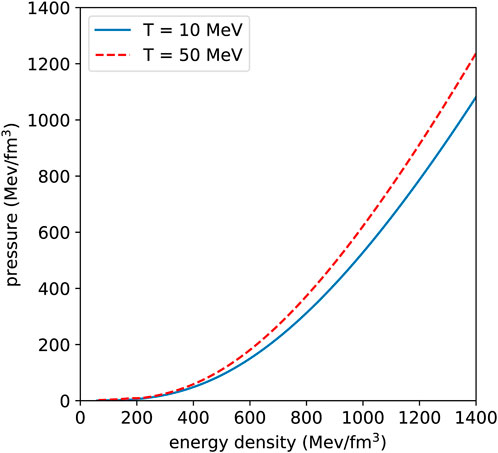- 1Department of Physics, San Diego State University, San Diego, CA, United States
- 2Department of Physics, University of California at San Diego, San Diego, CA, United States
- 3Department of Physics, Catholic Institute of Technology, Cambridge, MA, United States
- 4Instituto de Física, Universidade Federal Fluminense, Rio deJaneiro, Brazil
Introduction: This paper investigates the impact of differential rotation on the bulk properties and onset of rotational instabilities in neutron stars at finite temperatures up to 50 MeV.
Methods: Utilizing the relativistic Brueckner-Hartree-Fock (RBHF) formalism in full Dirac space, the study constructs equation of state (EOS) models for hot neutron star matter, including conditions relevant for high temperatures. These finite-temperature EOS models are applied to compute the bulk properties of differentially rotating neutron stars with varying structural deformations.
Results: The findings demonstrate that the stability of these stars against bar-mode deformation, a key rotational instability, is only weakly dependent on temperature. Differential rotation significantly affects the maximum mass and radius of neutron stars, and the threshold for the onset of bar-mode instability shows minimal sensitivity to temperature changes within the examined range.
Discussion: These findings are crucial for interpreting observational data from neutron star mergers and other high-energy astrophysical events. The research underscores the necessity of incorporating differential rotation and finite temperature effects in neutron star models to predict their properties and stability accurately.
1 Introduction
Neutron stars provide a unique, naturally occurring laboratory for studying matter at extreme pressures and densities not reproducible by experiments in terrestrial laboratories (see, for instance, [1–3]). The cold, highly isospin asymmetric matter within the core of a massive neutron star can reach densities up to an order of magnitude higher than nuclear saturation density. During a binary neutron star merger event, the resulting matter may promptly collapse into a black hole or form a remnant neutron star. If formed, the remnant star is characterized by a high mass, extreme temperatures on the order of 50–100 MeV, and rapid differential rotation [4–7]. These massive, differentially rotating remnant stars may also deviate from spherical or axial symmetry by exhibiting extreme triaxial deformations. The structural deformation, thermal pressure, and differential rotation allow the remnant to remain stable on short, dynamical timescales, for masses that would be otherwise unstable in the static and uniform-rotation cases.
Differential rotation in neutron stars has been explored in the literature through numerical simulations [8–11], with more recent studies incorporating finite temperature equation of state (EOS) models [12, 13]. The inclusion of temperature when modeling the EOS of neutron star matter, however, is a formidable task. Theoretical modeling of neutron star matter as a dense, many-body system can be done in a phenomenological or ab initio framework [3, 14–16, 16–18, 20]. Phenomenological models employ density functional theories with effective nucleon-nucleon (NN) interactions to reproduce the empirical saturation properties of symmetric nuclear matter while adhering to constraints extracted from nuclear physics and astrophysics [19, 21–23]. In contrast, ab initio methods use realistic NN interactions determined by nucleon-nucleon scattering data and the properties of the deuteron. Relativistic ab initio methods, such as the relativistic Brueckner-Hartree-Fock (RBHF) approximation, closely reproduce the saturation properties of empirical data [24–29]. The RBHF approximation couples the propagation of baryons to the many-body background and encapsulates dynamical correlations between baryons, computed using a relativistic scattering
While most studies using the RBHF approximation are conducted at zero temperature, our previous work [30] extended the approximation to model nuclear matter at finite temperatures, where EOS models were derived in different temperature regimes. The nuclear EOS models incorporate finite temperatures in a self-consistent manner, unlike previous studies that added thermal effects to models of cold nuclear matter [31–33]. This framework ensures a more comprehensive and accurate representation of the thermodynamic properties of dense nuclear matter. In previous work, these EOS models were used to determine bulk properties of non-rotating, uniformly rotating, and differentially rotating neutron stars.
In this paper, we expand on previous work by exploring more deformed stars and dynamical rotation instabilities. This paper is organized as follows: Section 2 describes the theoretical framework for deriving EOS models at finite temperatures using the RBHF approximation and for constructing equilibrium models of differentially rotating stars. Section 3 presents the calculated results, where Section 3.1 shows stellar sequences over ranges of structural deformation, Section 3.2 discusses the stability of calculated models to dynamical bar mode excitation, Section 3.3 presents density and frequency profiles for stars with high degrees of differential rotation and structural deformation, and Section 3.4 discusses how various approximations introduced in the numerical calculations may influence the presented results. Section 4 gives a summary of the work presented.
2 Theoretical framework
This section discusses the theoretical framework for constructing equation of state (EOS) models for neutron star matter at finite temperatures using the relativistic Brueckner-Hartree-Fock (RBHF) theory. The EOS models are used as input to construct equilibrium models of differentially rotating objects, for which the theory is described below.
2.1 Relativistic Brueckner-Hartree-Fock theory at finite temperatures
The essential structure of modeling nuclear matter using RBHF theory is outlined in this section. A more detailed explanation of the approach can be found in Poschenrieder and Weigel [24]; Weber [14], with finite temperature extensions given in our previous work [30, 34]. Nuclear matter at supranuclear densities can be described as a complex, many-body system whose dynamics are governed by the Lagrangian density:
where
The formal structure of the RBHF approach is to solve a system of highly nonlinear, coupled equations, which include the Dyson equation for the two-body Green’s function
where
where
The final coupled equation in the formal scheme is for the self-energy
The self-consistent calculations are carried out using a complete basis of particles
The particle propagator
where
where “1” indicates the positive energy states and “2” indicates the thermally-excited negative energy states. We recall here that at finite temperatures, the behavior of nuclear matter undergoes important modification, attributed to thermal baryonic excitations surpassing the Fermi surface. As
and for negative energy states,
An elegant technique used to make the many-body equations numerically tractable and to calculate the key quantities of many-body systems is to utilize the spectral representation of the
where
Once a self-consistent solution to the coupled system of equations is found, the self-energy
where
where
Both particles and antiparticles contribute to
Using the outlined theory, two models for the EOS of neutron star matter are constructed at temperatures T = 10 and 50 MeV, shown visually in Figure 1. As shown in previous work Farrell and Weber [30], the maximum mass of each EOS for non-rotating and uniformly rotating stellar sequences at their mass-shedding limit is over 2
2.2 Differential rotation
The theoretical framework for modeling differential rotation in neutron stars described in this work follows from the framework laid out by Komatsu et al. [40], which was then modified in Cook et al. [8] (referred to as CST throughout the text). The equations shown in this section directly follow the modifications introduced in CST.
To model differentially rotating neutron stars, we begin with the definition of the line element [8]:
where the metric potentials
where
where
Equilibrium models for neutron stars must obey the equation of hydrostatic equilibrium, which has the form:
where
where
Using the linear rotation law in Equation 4, the equation of hydrostatic equilibrium can be integrated to give:
where
As the rotation parameter
In the numerical scheme, the metric potentials (
which is equivalent to Equation 5 evaluated at the location of the maximum (denoted by subscript
where the subscript
3 Results
Equilibrium models of differentially rotating stars at finite temperatures are computed using the theoretical formalism described in the sections above. For the two EOS models at
3.1 Stellar sequences: Varying the ratio of polar to equatorial radius
In this section, stellar sequences are constructed over a range of constant central densities for the two EOS models at temperatures of 10 and 50 MeV. These sequences are calculated with a fixed value for the rotation parameter set the degree of differential rotation; as mentioned in Section 2.2, sequences are parameterized by fixing
For each EOS, sequences over a range of constant central densities are computed for varying values of
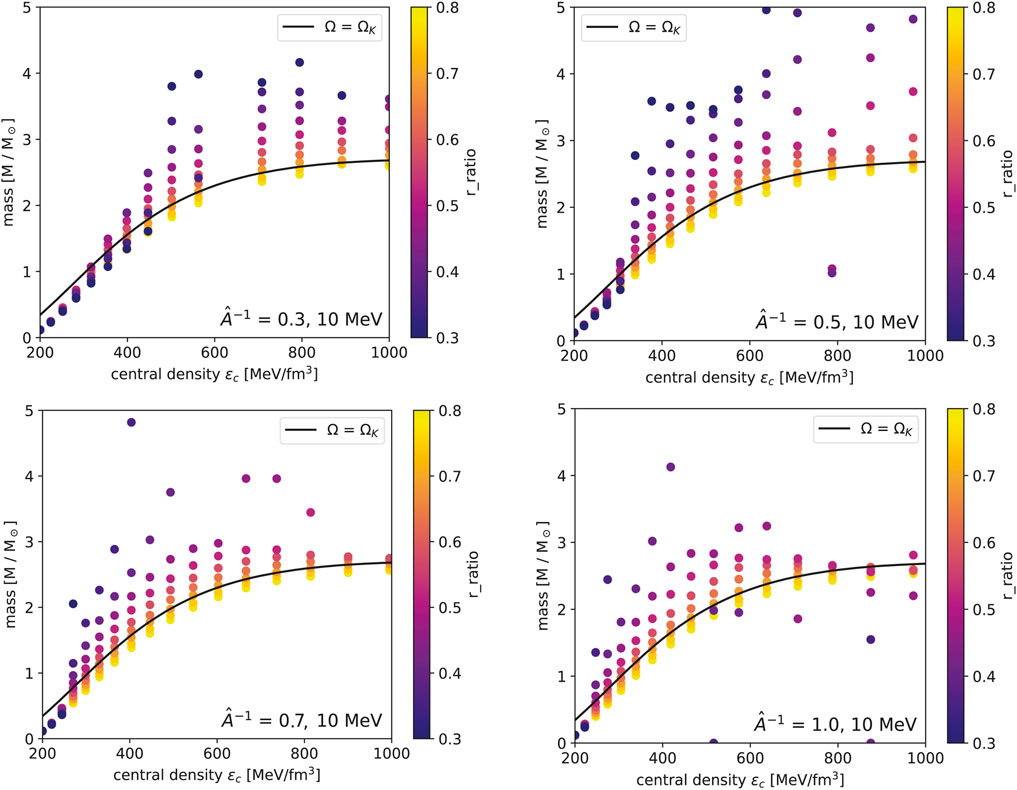
Figure 2. Mass vs. central density of sequences of differentially rotating neutron stars constructed using the EOS model at
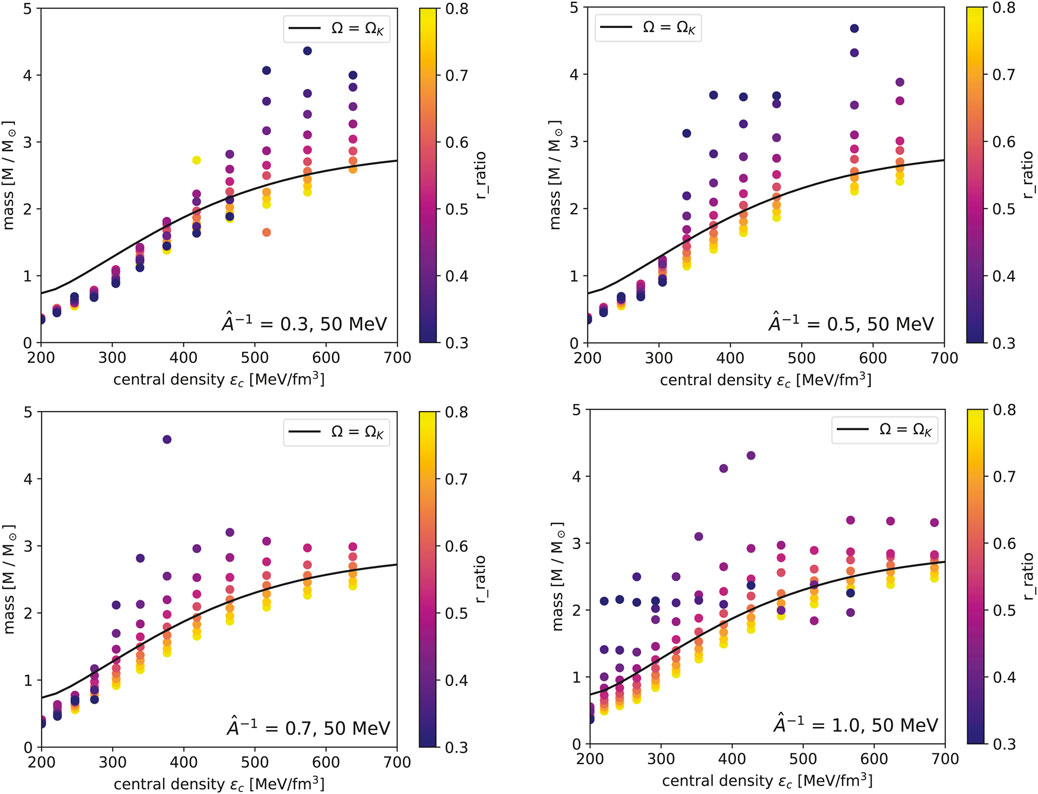
Figure 3. Mass vs. central density of differentially rotating neutron stars constructed using the EOS model at
3.2 Dynamical bar-mode instability
Rotating neutron stars formed from a core-collapse suprenova (CCSN) or binary stellar mergers may experience nonaxisymmetric instabilities that directly impact their rotation rates and overall stability. Previous studies (see [45, 46]) in Newtonian gravity have shown rotational instabilities arise from non-radial toroidal modes, i.e.,
Two mechanisms cause rotating stars to be unstable to bar-mode deformation: secular and dynamical instabilities. In Newtonian theory, uniformly rotating incompressible neutron stars become secularly unstable to bar-mode deformation at a critical value of
The dynamical bar-mode instability occurs independent of any dissipative mechanism and with a growth rate determined by the dynamical timescale of the system, which is generally faster than the timescale of growth for secular instabilities. Therefore, numerical simulations of hydrodynamical equations are necessary to determine the onset threshold of the dynamical bar-mode instability. Many simulations have been carried out in Newtonian theory, the consensus of which gives the critical value
The relativistic simulation of differentially rotating stars carried out by Shibata et al. [52] finds that the critical value of the stability parameter for the dynamic bar-mode instability is
A visual representation of stable and unstable models using this criterion at
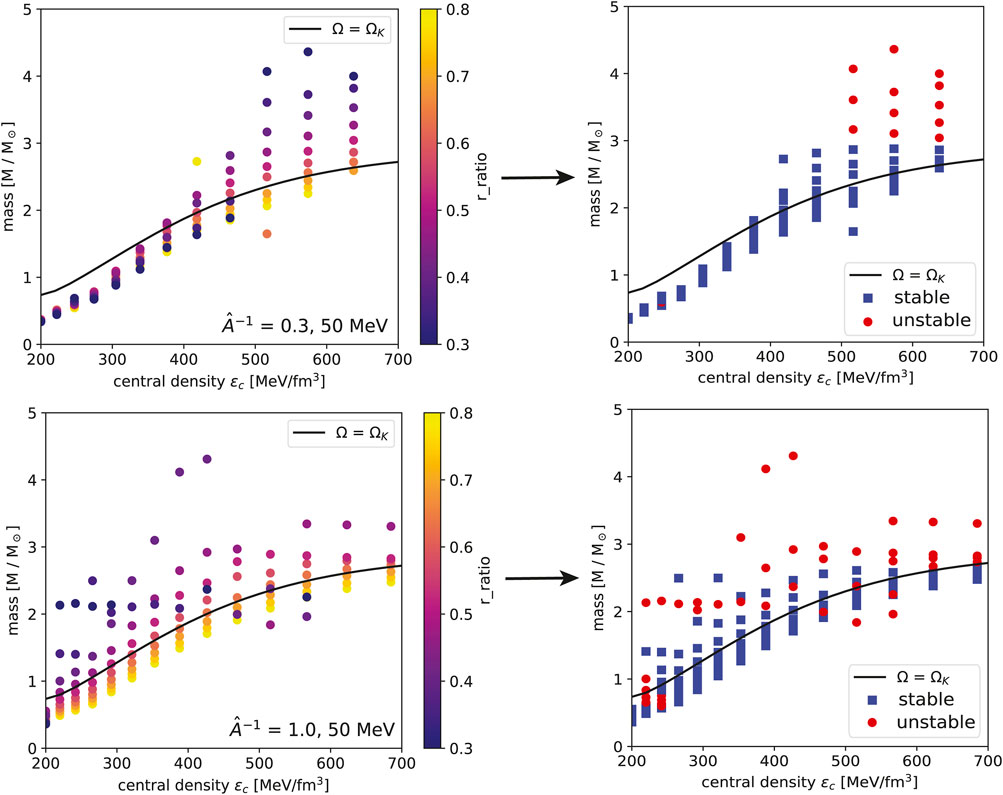
Figure 4. Mass vs. central density of differentially rotating stellar sequences using the EOS at
Table 1 gives the percentage of unstable models and the average
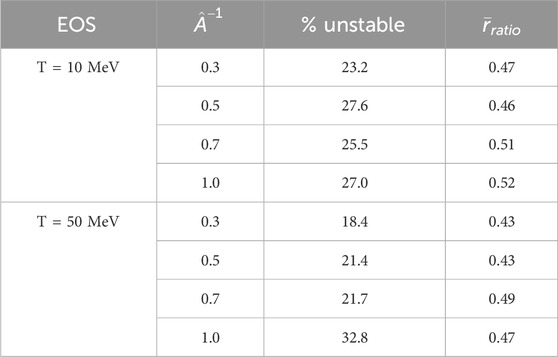
Table 1. The percentage of unstable models and the average
3.3 Structural deformation
In this section, we examine density and frequency maps of individual stellar models. For each temperature, two models are computed: the first with a lesser degree of differential rotation (

Table 2. Bulk properties of highly deformed neutron stars, all with
The density and frequency maps for
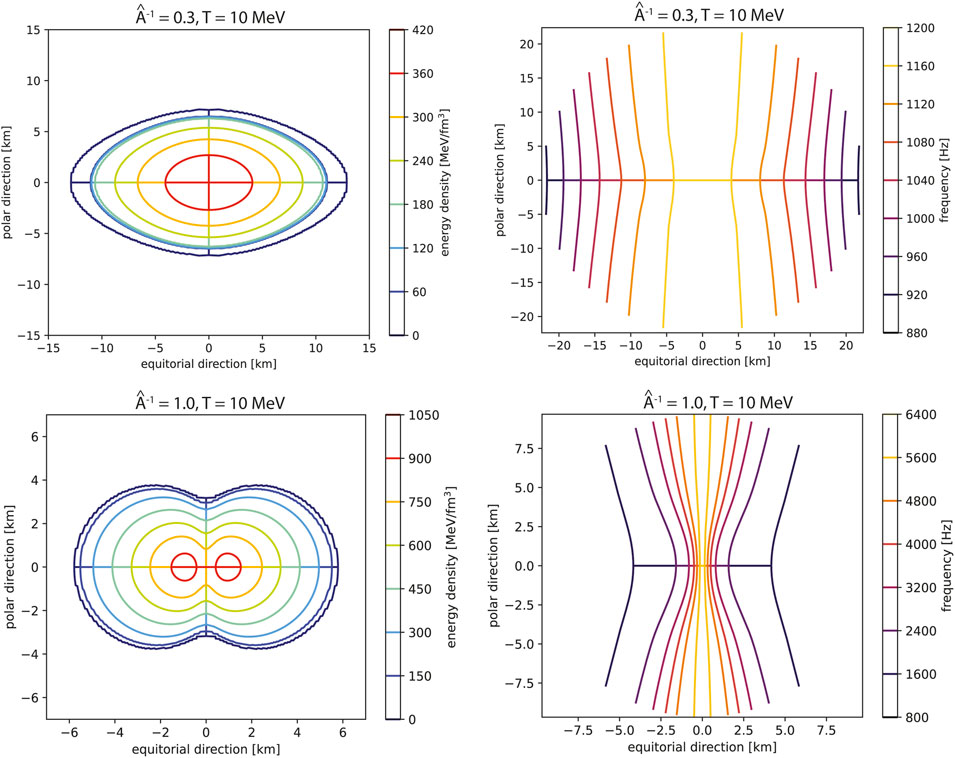
Figure 5. Energy density (left) and frequency (right) contours for individual stellar models at two degrees of differential rotation, constructed using the EOS model at
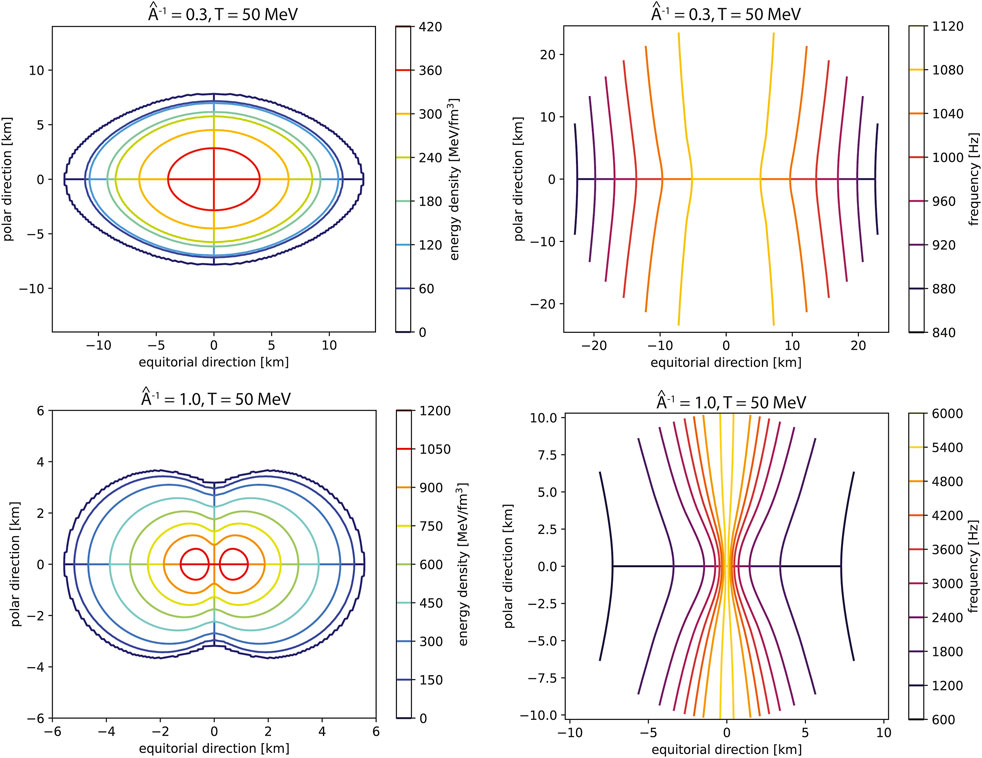
Figure 6. Energy density (left) and frequency (right) contours for individual stellar models at two degrees of differential rotation, constructed using the EOS model at
As shown in Section 3.2, the stability of the star depends not only on the deformation characterized by
The timescale over which the dynamical bar-mode instability develops, also known as the dynamical timescale, is proportional to
3.4 Key approximations
The preceding sections present results dependent on the the underlying theoretical frameworks discussed in Section 2, which employ important approximations, discussed below.
The finite temperature EOS models at
Variations in the choice of OBE potential and omission of quantum corrections, such as three-body forces, can introduce errors in the RBHF EOS of up to 10%, as demonstrated in Brockmann and Machleidt [36]. Using chiral effective field theory, Hebeler and Schwenk [61] and Tews et al. [62] concluded that including three-body forces affects neutron star radius and mass predictions by 5%–10%.
In addition, the EOS models include finite temperatures (10 MeV and 50 MeV), which are essential for modeling neutron stars formed in extreme events like supernovae or binary neutron star mergers Steiner et al. [63]. However, as mentioned before, the neutron star crust is assumed to be at zero temperature, while the core is modeled at finite temperatures. This approximation may introduce inconsistencies in the determination of properties like neutron star mass and radius, especially in higher temperature regimes. In particular, the radius increases due to thermal pressure in the crust, potentially making the star slightly larger.
When modeling differential rotation in neutron stars, the rotation profile, given in Equation 4, is parameterized by
For a comprehensive review discussing EOS uncertainties, neutron star mass-radius relationships, and the challenges of matching theoretical models with astrophysical data, see Lattimer and Prakash [65].
4 Discussion and conclusion
In this paper, we present a comprehensive investigation into the properties of differentially rotating neutron stars at finite temperatures up to 50 MeV. In Section 2.1, we detailed the process of constructing models for the equation of state of neutron star matter at two temperatures, 10 and 50 MeV, using the relativistic Brueckner-Hartree-Fock (RBHF) formalism modified to include thermal effects, utilizing the Bonn-B potential for the one-boson exchange (OBE) interaction. The inclusion of temperature is essential for the realistic modeling of extreme astrophysical events, such as binary neutron star (BNS) mergers or core-collapse supernovae, where differential rotation is prevalent.
The RBHF approach goes well beyond standard relativistic mean-field (RMF) calculations and relativistic Hartree-Fock (RHF) methods. The RBHF formalism includes the relativistic scattering
The two EOS models were used as input to the numerical scheme to determine the bulk properties of differentially rotating compact objects, focusing on heavily deformed objects characterized by the ratio of their polar to equatorial radii,
In Section 3.2, we explored the stability of the calculated stellar models against rotational instabilities, specifically the dynamical bar-mode instability. At a temperature of 10 MeV, the average
In Section 3.3, we presented individual stellar maps of density and frequency distributions for two degrees of differential rotation for each EOS model. As expected, the frequency range for higher degrees of differential rotation (and higher values of
The insights gained from this research are particularly relevant in the context of observations from current and future gravitational wave detectors such as LIGO [75], Virgo [76], KAGRA [77], and the upcoming Einstein Telescope [78]. Moreover, X-ray and radio telescopes, including the Chandra X-ray Observatory [79], XMM-Newton [80], the Very Large Array (VLA) [81], the Square Kilometre Array (SKA) [82], and the Five-hundred-meter Aperture Spherical Radio Telescope (FAST) [83] provide crucial observational data that can further constrain the models presented here.
Future work should extend these models to include additional physical effects, such as magnetic fields and more sophisticated treatments of thermal transport processes, to provide an even more comprehensive understanding of neutron star dynamics and stability under extreme conditions.
Data availability statement
The raw data supporting the conclusions of this article will be made available by the authors, without undue reservation.
Author contributions
DF: Conceptualization, Data curation, Formal Analysis, Investigation, Methodology, Software, Validation, Visualization, Writing–original draft, Writing–review and editing. FW: Conceptualization, Data curation, Formal Analysis, Funding acquisition, Investigation, Methodology, Project administration, Software, Supervision, Validation, Writing–original draft, Writing–review and editing. RN: Conceptualization, Funding acquisition, Methodology, Software, Validation, Writing–original draft, Writing–review and editing.
Funding
The author(s) declare that financial support was received for the research, authorship, and/or publication of this article. DF and FW are supported by the National Science Foundation (USA) under Grant No. PHY-2012152.
Conflict of interest
The authors declare that the research was conducted in the absence of any commercial or financial relationships that could be construed as a potential conflict of interest.
Publisher’s note
All claims expressed in this article are solely those of the authors and do not necessarily represent those of their affiliated organizations, or those of the publisher, the editors and the reviewers. Any product that may be evaluated in this article, or claim that may be made by its manufacturer, is not guaranteed or endorsed by the publisher.
References
1. Becker W. Neutron stars and pulsars. Astrophysics and space science library. Berlin Heidelberg: Springer (2009).
2. Reddy S. Neutron stars as astrophysical laboratories. Rev Mod Phys (2012) 84:85–120. doi:10.1103/RevModPhys.84.85
3. Burgio G, Schulze H-J, Vidaña I, Wei J-B. Neutron stars and the nuclear equation of state. Prog Part Nucl Phys (2021) 120:103879. doi:10.1016/j.ppnp.2021.103879
4. Shibata M, Uryu K. Simulation of merging binary neutron stars in full general relativity: γ= 2 case. Phys Rev D (2000) 61:064001. doi:10.1103/physrevd.61.064001
5. Shibata M, Kiuchi K. Gravitational waves from remnant massive neutron stars of binary neutron star merger: viscous hydrodynamics effects. Phys Rev D (2017) 95:123003. doi:10.1103/physrevd.95.123003
6. Fujibayashi S, Kiuchi K, Nishimura N, Sekiguchi Y, Shibata M. Mass ejection from the remnant of a binary neutron star merger: viscous-radiation hydrodynamics study. Astrophysical J (2018) 860:64. doi:10.3847/1538-4357/aabafd
7. Perego A, Bernuzzi S, Radice D. Thermodynamics conditions of matter in neutron star mergers. The Eur Phys J A (2019) 55:124. doi:10.1140/epja/i2019-12810-7
8. Cook GB, Shapiro SL, Teukolsky SA. Rapidly rotating neutron stars in general relativity: realistic equations of state. Astrophysical J (1994) 424:823–45. doi:10.1086/173934
9. Schaab C, Weigel MK. Differential rotation in neutron stars. Phys Lett B (1999) 450:187–94. doi:10.1016/S0370-2693(99)00195-3
10. Galeazzi F, Yoshida S, Eriguchi Y. Differentially-rotating neutron star models with a parametrized rotation profile. Astron & Astrophysics (2012) 541:A156. doi:10.1051/0004-6361/201016316
11. Hanauske M, Takami K, Bovard L, Rezzolla L, Font JA, Galeazzi F, et al. Rotational properties of hypermassive neutron stars from binary mergers. Phys Rev D (2017) 96:043004. doi:10.1103/physrevd.96.043004
12. Marques M, Oertel M, Hempel M, Novak J. New temperature dependent hyperonic equation of state: application to rotating neutron star models and i-q relations. Phys Rev C (2017) 96:045806. doi:10.1103/physrevc.96.045806
13. Camelio G, Dietrich T, Marques M, Rosswog S. Rotating neutron stars with nonbarotropic thermal profile. Phys Rev D (2019) 100:123001. doi:10.1103/physrevd.100.123001
14. Weber F. Pulsars as astrophysical laboratories for nuclear and particle physics series in high energy physics, cosmology and gravitation. FL, USA: CRC Press (1999). doi:10.1201/9780203741719
15. Glendenning N. Compact stars: nuclear physics particle physics and general relativity. Astronomy and astrophysics library (2012).
16. Spinella WM, Weber F. Dense baryonic matter in the cores of neutron stars. In: Topics on strong gravity: a modern view on theories and experiments (world scientific) (2020). p. 85–152.
17. Weber F, Farrell D, Spinella WM, Malfatti G, Orsaria MG, Contrera GA, et al. Phases of hadron-quark matter in (proto) neutron stars. Universe (2019) 5:169. doi:10.3390/universe5070169
18. Malfatti G, Orsaria MG, Contrera GA, Weber F, Ranea-Sandoval IF. Hot quark matter and (proto-) neutron stars. Phys Rev C (2019) 100:015803. doi:10.1103/PhysRevC.100.015803
19. Malfatti G, Orsaria MG, Ranea-Sandoval IF, Contrera GA, Weber F. Delta baryons and diquark formation in the cores of neutron stars. Phys Rev D (2020) 102:063008. doi:10.1103/PhysRevD.102.063008
20. Sedrakian A, Li JJ, Weber F. Heavy baryons in compact stars. Prog Part Nucl Phys (2023) 475:104041. doi:10.1016/j.ppnp.2023.104041
21. Lattimer JM, Steiner AW. Constraints on the symmetry energy using the mass-radius relation of neutron stars. Eur Phys J A (2014) 50:40–24. doi:10.1140/epja/i2014-14040-y
22. Lattimer JM. Neutron star mass and radius measurements. Universe (2019) 5:159. doi:10.3390/universe5070159
23. Stone JR. Nuclear physics and astrophysics constraints on the high density matter equation of state. Universe (2021) 7:257. doi:10.3390/universe7080257
24. Poschenrieder P, Weigel M. Nuclear matter problem in the relativistic green’s function approach. Phys Rev C (1988) 38:471–86. doi:10.1103/physrevc.38.471
25. Horowitz C, Serot BD. The relativistic two-nucleon problem in nuclear matter. Nucl Phys A (1987) 464:613–99. doi:10.1016/0375-9474(87)90370-8
26. Zuo W, Bombaci I, Lombardo U. Asymmetric nuclear matter from an extended brueckner-Hartree-Fock approach. Phys Rev C (1999) 60:024605. doi:10.1103/PhysRevC.60.024605
27. Wang S, Zhao Q, Ring P, Meng J. Nuclear matter in relativistic brueckner-Hartree-Fock theory with bonn potential in the full Dirac space. Phys Rev C (2021) 103:054319. doi:10.1103/physrevc.103.054319
28. Lovato A, Bombaci I, Logoteta D, Piarulli M, Wiringa RB. Benchmark calculations of infinite neutron matter with realistic two- and three-nucleon potentials. Phys Rev C (2022) 105:055808. doi:10.1103/PhysRevC.105.055808
29. Tong H, Wang C, Wang S. Nuclear matter and neutron stars from relativistic brueckner–Hartree–Fock theory. Astrophysical J (2022) 930:137. doi:10.3847/1538-4357/ac65fc
30. Farrell D, Weber F. Relativistic brueckner–Hartree–Fock calculations for cold and hot neutron stars. Astrophysical J (2024) 969:49. doi:10.3847/1538-4357/ad47b8
31. Faber JA, Rasio FA. Binary neutron star mergers. Living Rev Relativity (2012) 15:8–83. doi:10.12942/lrr-2012-8
32. Baiotti L, Rezzolla L. Binary neutron star mergers: a review of einstein’s richest laboratory. Rep Prog Phys (2017) 80:096901. doi:10.1088/1361-6633/aa67bb
33. Raithel CA, Özel F, Psaltis D. Finite-temperature extension for cold neutron star equations of state. Astrophysical J (2019) 875:12. doi:10.3847/1538-4357/ab08ea
34. Farrell D, Alp A, Weber F, Spinella W, Malfatti G, Orsaria MG, et al. Hot neutron star matter and proto-neutron stars. World Scientific (2023) 199–259. doi:10.1142/9789811220913_0005
35. Martin PC, Schwinger J. Theory of many-particle systems. i. Phys Rev (1959) 115:1342–73. doi:10.1103/physrev.115.1342
36. Brockmann R, Machleidt R. Relativistic nuclear structure. i. nuclear matter. Phys Rev C (1990) 42:1965–80. doi:10.1103/physrevc.42.1965
37. Wang C, Wang S, Tong H, Hu J, Yao J. Low-momentum relativistic nucleon-nucleon potentials: nuclear matter. Phys Rev C (2024) 109:034002. doi:10.1103/physrevc.109.034002
38. Dolan L, Jackiw R. Symmetry behavior at finite temperature. Phys Rev D (1974) 9:3320–41. doi:10.1103/PhysRevD.9.3320
39. ter Haar B, Malfliet R. Equation of state of nuclear matter in the relativistic Dirac-brueckner approach. Phys Rev Lett (1986) 56:1237–40. doi:10.1103/physrevlett.56.1237
40. Komatsu H, Eriguchi Y, Hachisu I. Rapidly rotating general relativistic stars–i. numerical method and its application to uniformly rotating polytropes. Monthly Notices R Astronomical Soc (1989) 237:355–79. doi:10.1093/mnras/237.2.355
41. Stergioulas N. Rotating stars in relativity. Living Rev Relativity (2003) 6:3–109. doi:10.12942/lrr-2003-3
42. Shapiro SL. Differential rotation in neutron stars: magnetic braking and viscous damping. Astrophysical J (2000) 544:397–408. doi:10.1086/317209
43. Morrison IA, Baumgarte TW, Shapiro SL. Effect of differential rotation on the maximum mass of neutron stars: realistic nuclear equations of state. Astrophysical J (2004) 610:941–7. doi:10.1086/421897
44. Zhou E, Tsokaros A, Uryu K, Xu R, Shibata M. Differentially rotating strange star in general relativity. Phys Rev D (2019) 100:043015. doi:10.1103/physrevd.100.043015
46. Shapiro SL, Teukolsky SA. Black holes, white dwarfs, and neutron stars: the physics of compact objects. John Wiley & Sons (2008).
47. Cutler C, Lindblom L. Post-Newtonian frequencies for the pulsations of rapidly rotating neutron stars. Astrophysical J (1992) 385:630–41. doi:10.1086/170968
48. Hunter C. On secular stability, secular instability, and points of bifurcation of rotating gaseous masses. Astrophysical J (1977) 213:497–517. doi:10.1086/155181
49. Paschalidis V, Stergioulas N. Rotating stars in relativity. Living Rev Relativity (2017) 20:7–169. doi:10.1007/s41114-017-0008-x
50. Saijo M, Shibata M, Baumgarte TW, Shapiro SL. Dynamical bar instability in rotating stars: effect of general relativity. Astrophysical J (2001) 548:919–31. doi:10.1086/319016
51. Bodenheimer P, Ostriker JP. Rapidly rotating stars. viii. zero-viscosity polytropic sequences. Astrophysical J (1973) 180:159–70. doi:10.1086/151951
52. Shibata M, Baumgarte TW, Shapiro SL. The bar-mode instability in differentially rotating neutron stars: simulations in full general relativity. Astrophysical J (2000) 542:453–63. doi:10.1086/309525
53. Shibata M, Karino S, Eriguchi Y. Dynamical instability of differentially rotating stars. Monthly Notices R Astronomical Soc (2002) 334:L27–L31. doi:10.1046/j.1365-8711.2002.05724.x
54. Camarda KD, Anninos P, Fragile PC, Font JA. Dynamical bar-mode instability in differentially rotating magnetized neutron stars. Astrophysical J (2009) 707:1610–22. doi:10.1088/0004-637x/707/2/1610
55. Di Giovanni F, Sanchis-Gual N, Cerdá-Durán P, Zilhao M, Herdeiro C, Font JA, et al. Dynamical bar-mode instability in spinning bosonic stars. Phys Rev D (2020) 102:124009. doi:10.1103/physrevd.102.124009
56. Ring P. Relativistic mean field theory in finite nuclei. Prog Part Nucl Phys (1996) 37:193–263. doi:10.1016/0146-6410(96)00054-3
57. Akmal A, Pandharipande V, Ravenhall D. Equation of state of nucleon matter and neutron star structure. Phys Rev C (1998) 58:1804–28. doi:10.1103/physrevc.58.1804
58. Epelbaum E, Hammer H-W, Meissner U-G. Modern theory of nuclear forces. Rev Mod Phys (2009) 81:1773–825. doi:10.1103/RevModPhys.81.1773
59. Sammarruca F, Chen B, Coraggio L, Itaco N, Machleidt R. Dirac-brueckner-Hartree-Fock versus chiral effective field theory. Phys Rev C—Nuclear Phys (2012) 86:054317. doi:10.1103/physrevc.86.054317
60. Shen S, Liang H, Meng J, Ring P, Zhang S. Fully self-consistent relativistic brueckner-Hartree-Fock theory for finite nuclei. Phys Rev C (2017) 96:014316. doi:10.1103/physrevc.96.014316
61. Hebeler K, Schwenk A. Chiral three-nucleon forces and neutron matter. Phys Rev C (2010) 82:014314. doi:10.1103/physrevc.82.014314
62. Tews I, Krüger T, Hebeler K, Schwenk A. Neutron matter at next-to-next-to-next-to-leading order in chiral effective field theory. Phys Rev Lett (2013) 110:032504. doi:10.1103/physrevlett.110.032504
63. Steiner A, Hempel M, Fischer T. Core-collapse supernova equations of state. Astrophysical J (2013) 774:17. doi:10.1088/0004-637x/774/1/17
64. Baumgarte T, Shapiro S. On the maximum mass of differentially rotating neutron stars. Astrophysical J (2003) 585:921–8. doi:10.1086/312425
65. Lattimer J, Prakash M. Neutron star structure and the equation of state. Astrophysical J (2001) 550:426–42. doi:10.1086/319702
66. Lattimer JM, Prakash M. Neutron star observations: progress and problems. Phys Rep (2007) 442:109–65. doi:10.1016/j.physrep.2007.02.003
67. Chirenti CL, Rezzolla L. The merger of two neutron stars: gravitational waves and electromagnetic signals. Astrophysical J (2012) 760:150. doi:10.1088/0004-637X/760/2/150
68. Metzger BD, Berger E. Kilonovae. Annu Rev Astron Astrophysics (2012) 50:503–46. doi:10.1146/annurev-astro-081811-125339
69. Zhang B. The origin of long-duration gamma-ray bursts. Nat Phys (2016) 12:737–41. doi:10.1038/nphys3805
70. Abbott BP, Abbott R, Abbott T, Acernese F, Ackley K, Adams C, et al. Gw170817: observation of gravitational waves from a binary neutron star inspiral. Phys Rev Lett (2017) 119:161101. doi:10.1103/PhysRevLett.119.161101
71. Kasen D, Metzger B, Barnes J, Quataert E, Ramirez-Ruiz E Kilonova from the ejecta of a neutron star merger. Nature (2017) 551:80–84. doi:10.1038/nature24063
72. Margalit B, Metzger BD. Constraining the maximum mass of neutron stars from multi-messenger observations of GW170817. Astrophysical J Lett (2017) 850:L19. doi:10.3847/2041-8213/aa991c
73. Piro AL. The role of neutron star merger kinematics in explaining the diversity of short gamma-ray bursts. Astrophysical J (2019) 885:10. doi:10.3847/1538-4357/ab3f99
74. Orsaria MG, Malfatti G, Mariani M, Ranea-Sandoval IF, García F, Spinella WM, et al. Phase transitions in neutron stars and their links to gravitational waves. J Phys G: Nucl Part Phys (2019) 46:073002. doi:10.1088/1361-6471/ab1d81
75. Aasi J, Abbott B, Abbott R, Abernathy MR, Ackley K, Adams C, et al. Advanced ligo. Class Quan Gravity (2015) 32, 074001, doi:10.1088/0264-9381/32/7/074001
76. Acernese F, Agathos M, Agatsuma K, Aisa D, Allemandou N, Allocca A, et al. Advanced virgo: a second-generation interferometric gravitational wave detector. Classical Quan Gravity (2015) 32:024001. doi:10.1088/0264-9381/32/2/024001
77. Aso Y, Michimura Y, Somiya K, Ando M, Mio N, Sekiguchi T, et al. Kagra: 2.5 generation interferometric gravitational wave detector. Phys Rev D (2020) 88:043007. doi:10.1103/physrevd.88.043007
78. Punturo M, Abernathy M, Acernese F, Allen B, Andersson N, Arun K, et al. The einstein telescope: a third-generation gravitational wave observatory. Classical Quan Gravity (2010) 27:194002. doi:10.1088/0264-9381/27/19/194002
79. Weisskopf M, Tananbaum H, Van Speybroeck L, O’Dell S The chandra x-ray observatory: exploring the high-energy universe, 112. WA, USA: Publications of the Astronomical Society of the Pacific (2000). 586.
80. Jansen F, Lumb D, Altieri B, Clavel J, Ehle M, Erd C, et al. The xmm-Newton observatory. Astron & Astrophysics (2001) 365. doi:10.1051/0004-6361:20000036
81. Perley R, Chandler C, Butler B, Wrobel J. The expanded very large array: a new telescope for new science. Astrophysical J Lett (2011) 739:L1. doi:10.1088/2041-8205/739/1/l1
82. Braun R, Bourke T, Green JA, Keane E, Wagg J The square kilometre array. Proc Sci AASKA14 (2015) 174.
Keywords: neutron star, differential rotation, equation of state, brueckner-Hartree-Fock, finite temperature field theory, bar mode instability
Citation: Farrell D, Weber F and Negreiros R (2024) Differential rotation in neutron stars at finite temperatures. Front. Phys. 12:1474615. doi: 10.3389/fphy.2024.1474615
Received: 01 August 2024; Accepted: 30 September 2024;
Published: 22 October 2024.
Edited by:
James Lattimer, Stony Brook University, United StatesReviewed by:
Jacobo Ruiz De Elvira, Complutense University of Madrid, SpainJiangming Yao, Zhuhai Campus, China
Copyright © 2024 Farrell, Weber and Negreiros. This is an open-access article distributed under the terms of the Creative Commons Attribution License (CC BY). The use, distribution or reproduction in other forums is permitted, provided the original author(s) and the copyright owner(s) are credited and that the original publication in this journal is cited, in accordance with accepted academic practice. No use, distribution or reproduction is permitted which does not comply with these terms.
*Correspondence: Delaney Farrell, ZGZhcnJlbGxAc2RzdS5lZHU=
 Delaney Farrell
Delaney Farrell Fridolin Weber
Fridolin Weber Rodrigo Negreiros
Rodrigo Negreiros